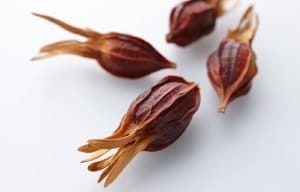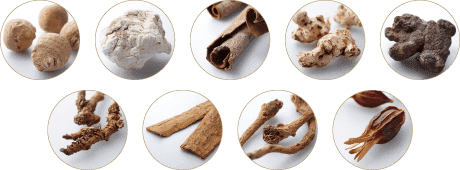
Crude drugs are medicinal products obtained from natural sources such as plants, animals, and minerals. Plant-derived ingredients are called “Sokonmokuhi (herbal medicine)” and their efficacy has been demonstrated by the wisdom of our forefathers.
Nine crude drugs are used to formulate “Goreioge.” Let me briefly describe each of these.
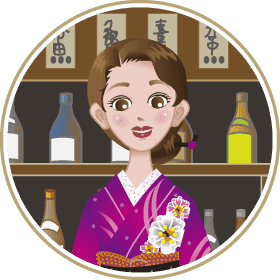
Takusya (Alisma tuber)
The tuber of Alisma orientale Juzepczuk (Alismaceae) from which the periderm has been usually removed. It has an effect on body fluids and promotes water metabolism.
Omodaka (Alisma), shaped like an arrowhead, was considered a “victory plant” and the Omodaka design on family crests was popular among the Sengoku warriors.
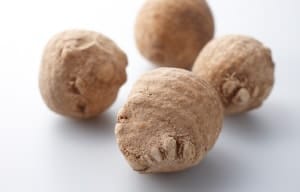
Bukuryo (Poria sclerotium)
The sclerotium of the fungus Wolfiporia cocos Ryvarden et Gilbertson (Poria cocos Wolf) (Polyporaceae). In the ancient kampo medicine text “Shinnohonzokyo,” poria sclerotium is listed in the “Johon (upper herbs),” which is a collection of drugs intended to nourish life. In kampo medicine, it is said to relieve “suitai” (body fluid retention), and is used to treat anorexia and dyspepsia caused by fluid retained in the stomach.
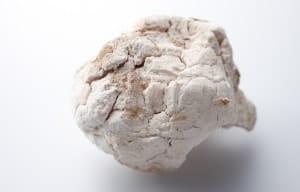
Keihi (Cinnamon bark)
The bark of Cinnamomum cassia Blume (Lauraceae), commonly known as cinnamon.
It is widely used as a spice or an aromatic stomach medicine.
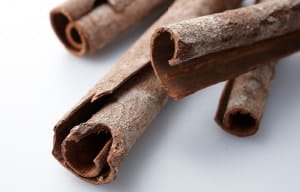
Chorei (Polyporus sclerotium)
The sclerotium of Polyporus umbellatus Fries (Polyporaceae). It has an effect on body fluids and is expected to rid the body of “shitsu” (dampness) in kampo medicine.
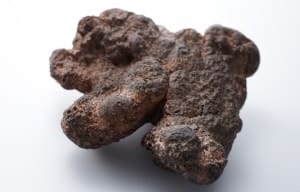
Byakujutsu (Atractylodes rhizome)
The rhizome of Atractylodes japonica Koidzumi ex Kitamura or Atractylodes ovata De Candolle (Composit). It is listed as “Zhu” in the “Johon” of “Shinnohonzokyo.”
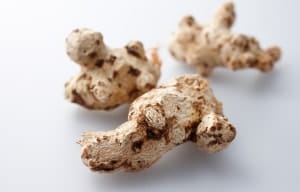
Oren (Coptis rhizome)
The rhizome of Coptis chinensis Franchet, C. deltoidea C.Y. Cheng et Hsiao, or C. teeta Wallich (Ranunculaceae) from which most of the roots have been removed.
Berberine, an ingredient present in the rhizome, is a stomachic.
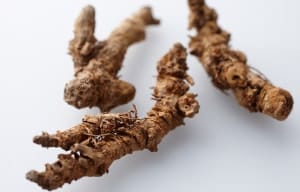
Obaku (Phellodendron bark)
The bark of Phellodendron amurense Ruprecht or P. chinense Schneider (Rutaceae) from which the outer layer has been removed. It is characterized by a bright yellow color and has been used as a bitter stomachic medicine.
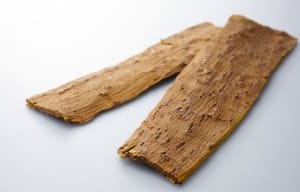
Ogon (Scutellaria root)
The root of Scutellaria baicalensis Georgi (Labiatae) from which the periderm has been removed. It is known to remove “shitsunetsu” (dampness-heat) in kampo medicine.
Known as “Koganebana” (golden herb) in Japanese, it is said to have been named after its yellow roots. It bears purplish-red flowers.
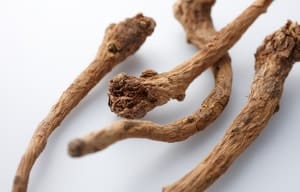
Sanshishi (Gardenia fruit)
The fruit of Gardenia jasminoides Ellis (Rubiaceae). It has the action of “seinetsu” (heat clearing) in kampo medicine and alleviates hyperemic inflammation. Called “Kuchinashi” (without a mouth) in Japanese, it is said to have been named after the fruit that does not open even when ripe, despite various theories about its etymology.
